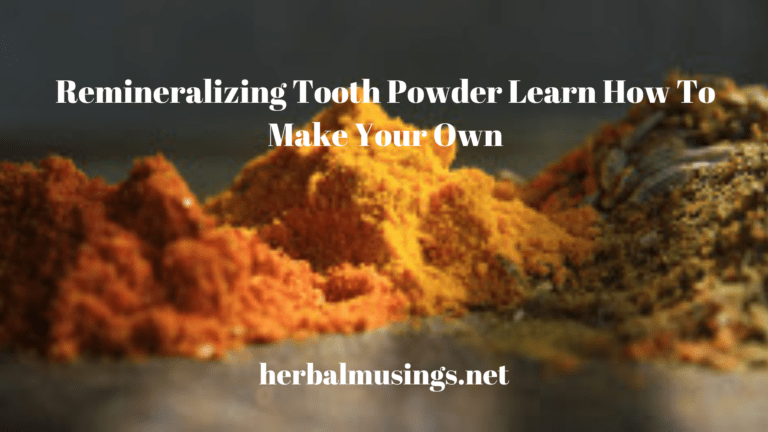I haven’t used store bought toothpaste ever since I really read the toothpaste labels about 7 years ago. So I started making my own toothpaste and tooth powder.
Most commercial toothpastes even many of the “natural” ones contain fluoride. A Harvard study recently linked fluoride to lowered IQ in children, while additional research has associated it with weakened bones, thyroid suppression, lowered metabolic function and dementia. (source 2, source 3).
Glycerin is another product in many commercial toothpastes because it makes the paste creamy and prevents it from drying out. But glycerin coats the teeth that prevents normal tooth remineralization.
What I Use In Tooth Powder
Bentonite clay – is a natural clay that has the unique ability to bind to toxins in the body. This clay is especially useful in eliminating toxins of heavy metals in your mouth such as mercury from fillings. This clay will never bind to any of the beneficial elements in your body. Bentonite clay is rich in minerals that nourish your teeth and gums.
Baking soda – is a trusted tooth cleanser long before it was added to the tubes you see on store shelves. It gently polishes teeth and naturally whitens your smile. Baking soda is less abrasive than commercial toothpastes.
*I omitted the baking soda because I didn’t like the salty taste. I use diatomaceous earth instead for the cleanser.
Diatomaceous earth – is amazing for remineralizing your teeth. It adds an abrasiveness to the tooth powder, but it’s not as salty as baking soda. Using diatomaceous earth helps if you’re sensitive to baking soda.
Sage – has been recognized by many cultures for its natural tooth-whitening abilities. Known for its astringent properties, sage is perfect for oral health and whitening discolored teeth.
Sea salt – pure sea salt is full of tooth-nourishing minerals and is especially helpful in healing irritated gums.
Peppermint essential oil – this essential oil has antibacterial, antiseptic, and pain-relieving properties. Peppermint is beneficial for mouth and gum infections. It adds a cool, minty fresh flavor to this tooth powder. If you don’t like peppermint you can substitute spearmint to create a different minty twist.
Tooth Powder
Ingredients
- 2 tablespoons bentonite clay
- 1 teaspoon baking soda* see above
- 2 teaspoons diatomaceous earth
- 1 tablespoon dried, finely ground sage leaf
- 1 ½ teaspoons unrefined stevia powder
- 1 teaspoon pure sea salt
- 2 tablespoons dried, finely ground mint leaf OR 15-20 drops peppermint essential oil
- Small glass or plastic jar
Directions
- Combine dry ingredients in a glass bowl and mix thoroughly with a non-metal spoon.
- If using essential oils, drip the oils into the mixture and stir well to combine.
- Transfer to a small glass or plastic container or jar with a tight fitting lid. Particles in the tooth powder are fine enough so you can use a small squirt bottle as long as you don’t get the tip wet because that causes clogging.
- To brush with tooth powder, simply dip your damp toothbrush into the powder, or carefully squirt some onto a wet toothbrush. Brush teeth as usual.
- Follow with homemade mouthwash if desired.
- Makes ~ 4 oz of tooth powder.
If using the dip method to get powder onto your toothbrush, you may want to consider giving each family member his/her own container.
Note: Bentonite clay loses its beneficial properties if it comes into contact with metal. It’s best to use plastic or glass when mixing and storing your tooth powder.
Mix up the dried herbs you use for your tooth powder! Consider using cinnamon or cloves for their antiseptic qualities. What other herbs would be good for your tooth powder?
It is so easy to make your own tooth powder and you know what the ingredients are. Why not give this tooth powder a try today?
This post may contain affiliate/referral links. Read my full Disclosure/Disclaimer Policy.
